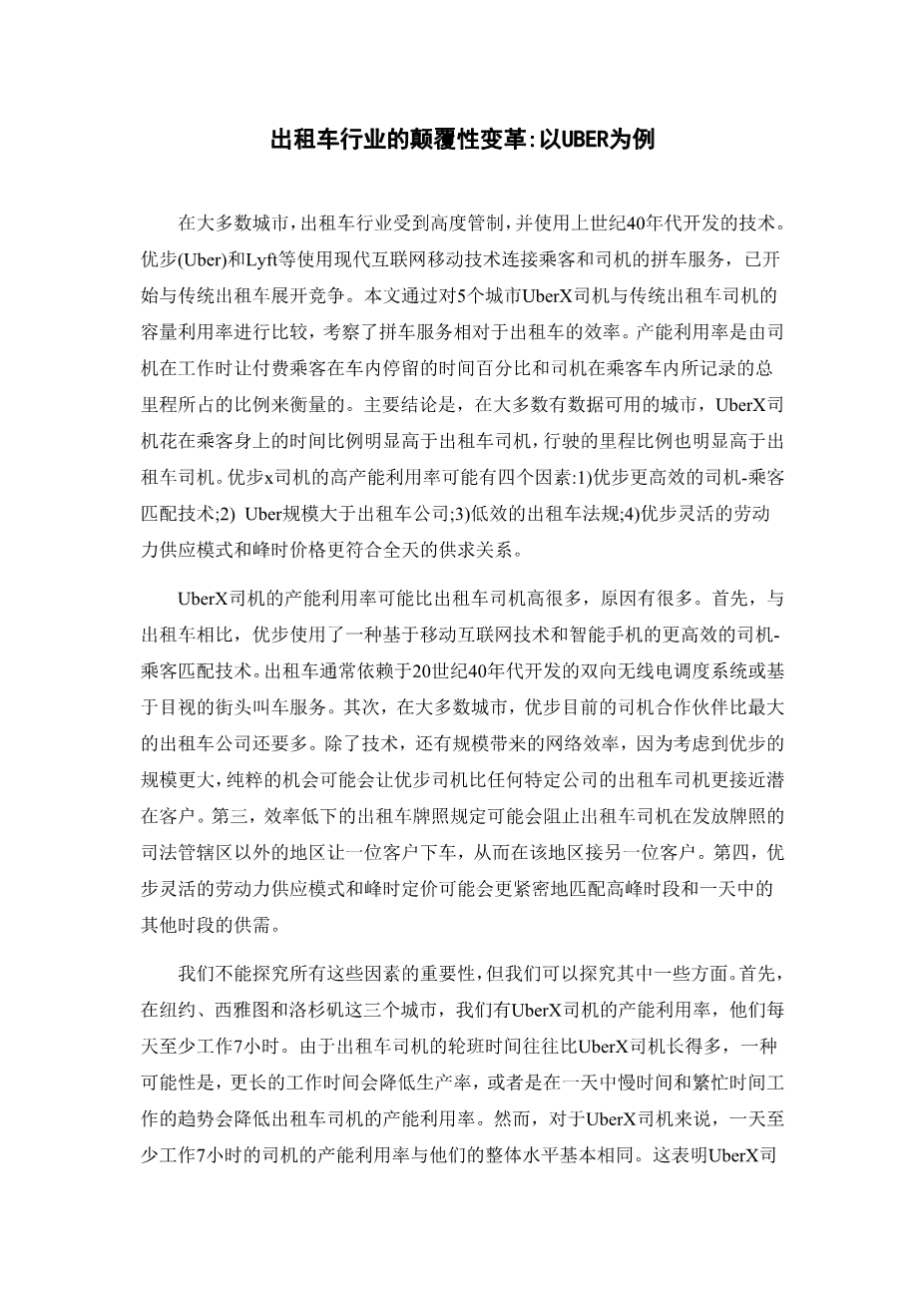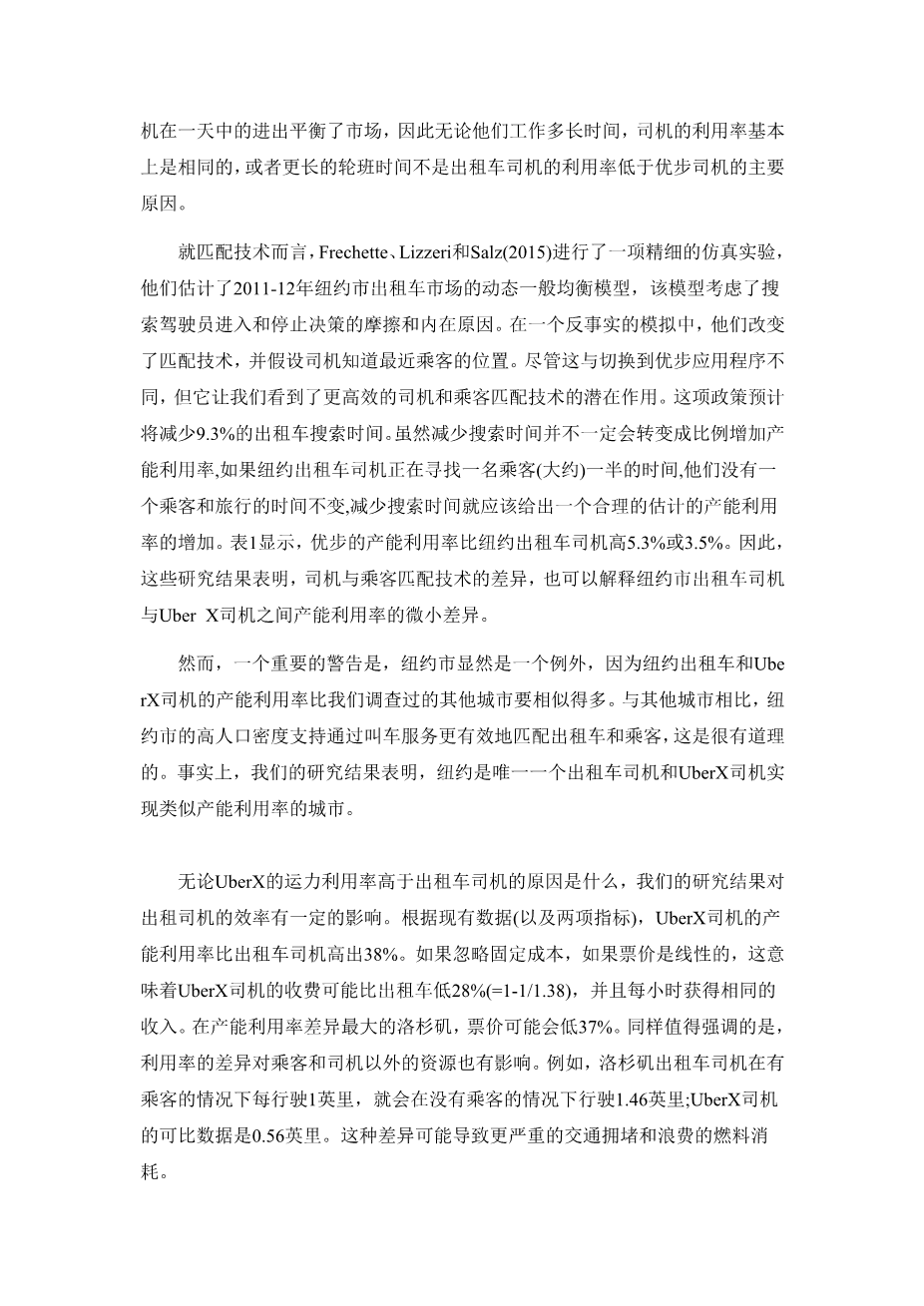Disruptive Change in the Taxi Business : the Case of Uber
In most cities, the taxi industry is highly regulated and utilizes technology developed in the 1940s. Ride sharing services such as Uber and Lyft, which use modern internet-based mobile technology to connect passengers and drivers, have begun to compete with traditional taxis. This paper examines the efficiency of ride sharing services vis-agrave;-vis taxis by comparing the capacity utilization rate of UberX drivers with that of traditional taxi drivers in five cities. The capacity utilization rate is measured by the fraction of time a driver has a fare-paying passenger in the car while he or she is working, and by the share of total miles that drivers log in which a passenger is in their car. The main conclusion is that, in most cities with data available, UberX drivers spend a significantly higher fraction of their time, and drive a substantially higher share of miles, with a passenger in their car than do taxi drivers. Four factors likely contribute to the higher capacity utilization rate of UberX drivers: 1) Uberrsquo;s more efficient driver-passenger matching technology; 2) the larger scale of Uber than taxi companies; 3) inefficient taxi regulations; and 4) Uberrsquo;s flexible labor supply model and surge pricing more closely match supply with demand throughout the day.
There are several possible reasons why UberX drivers may achieve significantly higher capacity utilization rates than taxi drivers. First, Uber utilizes a more efficient driver-passenger matching technology based on mobile internet technology and smart phones than do taxis, which typically rely on a two-way radio dispatch system developed in the 1940s or sight-based street hailing. Second, in most cities Uber currently has more driver partners on the road than the largest taxi cab company. Apart from the technology, there are network efficiencies from scale, as pure chance would likely result in an Uber driver being closer to a potential customer than a taxi driver from any particular company given the larger scale of Uber. Third, inefficient taxi licensing regulations can prevent taxi drivers who drop off a customer in a jurisdiction outside of the one that granted their license from picking up another customer in that location. Fourth, Uberrsquo;s flexible labor supply model and surge pricing probably more closely matches supply with demand during peak demand hours and other hours of the day.
We cannot explore the importance of all of these factors, but we can explore aspects of some of them. First, for three cities -- New York, Seattle and LA – we have capacity utilization rates for UberX drivers who worked at least 7 hours in the day. Because taxi drivers tend to work much longer shifts than UberX drivers, one possibility is that the longer work day reduces productivity, or the tendency to work during both slow and busy times of the day lowers the capacity utilization rate of taxi drivers. For UberX drivers, however, the capacity utilization rates were essentially identical for the drivers who worked at least 7 hours in the day as they were for drivers as a whole. This suggests that the exit and entry of UberX drivers during the course of the day equilibrates the market so that drivers achieve essentially the same utilization rate regardless of how long they work, or that longer shifts are not the central reason why taxi drivers have lower utilization rates than Uber drivers.
Insofar as matching technology is concerned, Frechette, Lizzeri and Salz (2015) conducted an elaborate simulation exercise where they estimated a dynamic general equilibrium model of the taxi market in New York City in 2011-12, allowing for search frictions and endogenous driver entry and stopping decisions. In one counterfactual simulation, they changed the matching technology and assumed that drivers knew the location of the closest passenger. Although this is not the same as switching to the Uber app, it gives a flavor for the potential role of more efficient technology for matching drivers and passengers. This policy was estimated to reduce the search time for taxis by 9.3 percent. Although a reduction in search time does not necessarily translate into a proportional increase in the capacity utilization rate, if New York taxi drivers are searching for a passenger in the (roughly) half of the time that they are without a passenger and the duration of trips is unchanged, then the reduction in search time should give a plausible estimate of the rise in the capacity utilization rate. Table 1 indicated that the capacity utilization rate is 5.3 percent or 3.5 percent higher for Uber than taxi drivers in New York. So these findings suggest that differences in driver-passenger matching technology can more than account for the minor difference in capacity utilization rate between taxi drivers and Uber X drivers in New York City.
An important caveat, however, is that New York City is an apparent outlier in that the capacity utilization rates of taxi and UberX drivers are much more similar in New York than in other cities we have been able to examine. It is quite plausible that the high population density of New York City supports more efficient matching of taxis and passengers through street hailing than is the case in other cities. Indeed, our results suggest that New York is the only city where taxi and UberX drivers achieve a similar capacity utilization rate.
Regardless of the reasons for the higher capacity utilization rate of UberX compared to taxi drivers, our findings have implications for the efficiency of for-hire drivers. Averaging across the five cities with available data (and across the two measures), the capacity utilization rate is 38 percent higher for UberX drivers than for taxi drivers. Ignoring fixed costs, if fares are linear, this implies that UberX drivers could charge 28 percent (=1-1/1.38) less than taxis
剩余内容已隐藏,支付完成后下载完整资料


英语译文共 3 页,剩余内容已隐藏,支付完成后下载完整资料
资料编号:[609604],资料为PDF文档或Word文档,PDF文档可免费转换为Word


